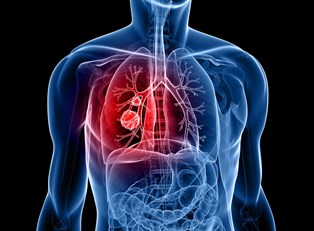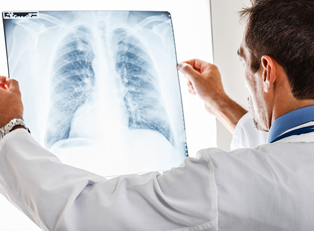Small-cell lung cancer represents between 10% and 15% of all lung cancer diagnoses. The most common cause of lung cancer, including small-cell, is tobacco smoking. Smoking not only predisposes the smoker to lung cancer, it also raises the likelihood of development in anyone routinely sharing the smoker's space. Other causes of lung cancer include genetic predisposition, radiation exposure such as for the treatment of breast cancer, exposure to asbestos, nickel, radon, and air pollution, or other inhaled irritants, and being HIV positive.
All lung cancers are the result of changes in the cells that line of the airways and air sacs of the lungs. Current research proposes that all lung cancers begin as small-scale changes in the tissue, such as an increase in the malignant cells' rate of growth, and then progress to true cancer as the body begins to make new blood vessels to feed cell and tumor growth. It is at this point that small-cell cancer of the lungs becomes visible to diagnostic imaging technology as a dense area on an x-ray, for example. Cancer has metastasized when a piece of that tumor breaks off, spreads through the body, and takes root in another organ, the lymphatic system, or, in rare cases, in the blood as a new grouping of cancerous cells.
Symptoms and Diagnosis
Lung cancer can develop without symptoms in its early stage; thus, when symptoms do begin to appear, the disease may be untreatable. However, with new technologies the rate of early diagnosis is improving. Many of the symptoms of lung cancer mimic other diseases like chronic bronchitis, chronic pneumonia, or Chronic Obstructive Pulmonary Disease (COPD). The American Cancer Society lists the following as symptoms of lung cancer:
- Persistent cough
- Chest pain that is often worse with deep breathing, coughing, or laughing
- Hoarseness
- Weight loss and loss of appetite
- Coughing up rust-colored sputum
- Shortness of breath
- Tiredness or Weakness,/li>
- Persistent infections such as bronchitis or pneumonia
- New onset of wheezing
Lung cancer is diagnosed through an array of tests, beginning with a chest x-ray, a CT scan, sputum cytology, and finally, fine-needle aspiration biopsy of the lung if the x-ray or CT scan has shown a mass. A bronchoscopy may be used to look for changes in the trachea and major bronchi. Surgical tests can include performing surgery of the chest cavity to examine non-central parts of the lung or the lymph nodes, or a mediastinoscopy through an incision in the neck to examine the organs, tissues, and fluids around the lungs for abnormalities.
Treatment
Sadly, there is no technological or medical intervention available today that can completely cure small-cell lung cancer. However, there are a number of treatments that can both prolong and improve the quality of life for a patient. There are ongoing clinical trials being conducted on all stages of small-scale lung cancer; the National Cancer Institute, one of the primary shareholders in this research, has a zip-code based search engine that can locate the nearest to the patient.



